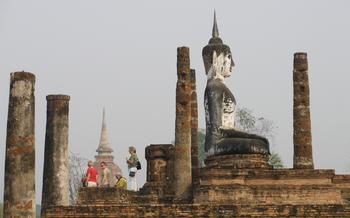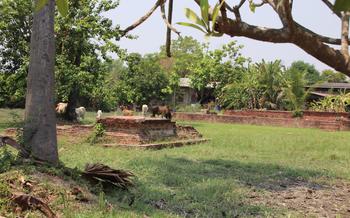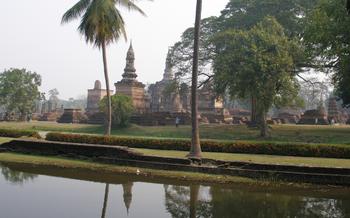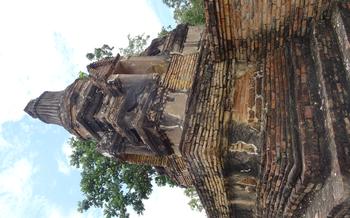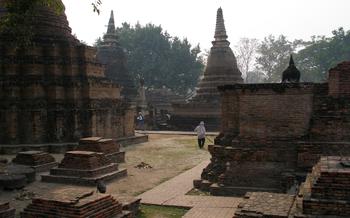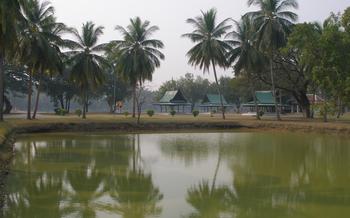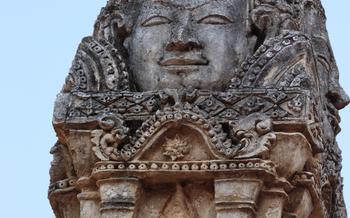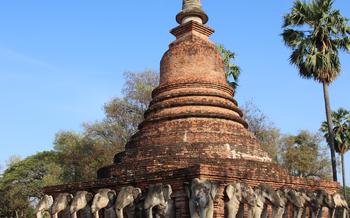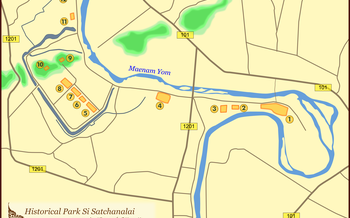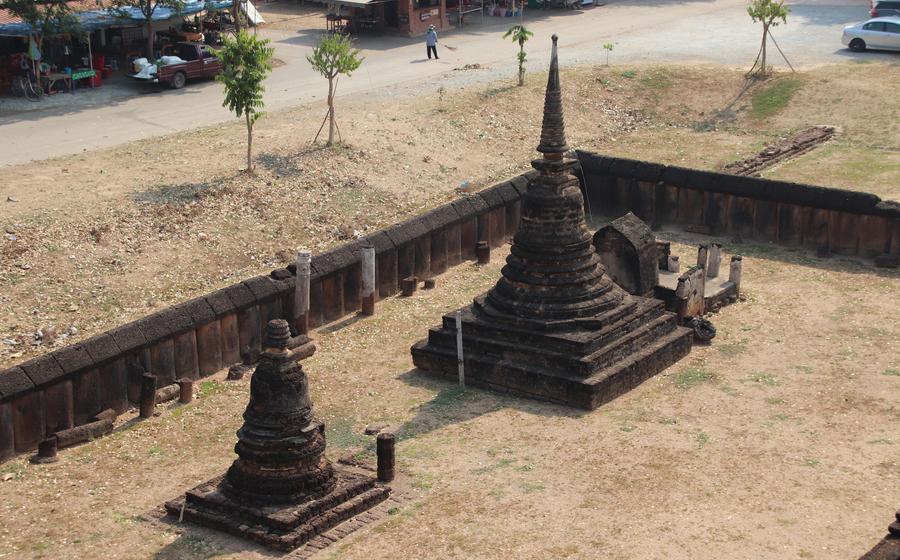
Wat Phra Si Rattana Mahathat
- History and Significance
- Architectural Features and Design
- Religious Ceremonies and Festivals
- Exploring the Temple Grounds
- Tips for Visitors
- Immerse in the Local Culture: Exploring the Vibrant Charm of Sukhothai
- Sukhothai Airport (THS) is the nearest airport to Wat Phra Si Rattana Mahathat, located approximately 30 kilometers from the temple complex. From the airport, visitors can take a taxi or rent a car to reach the temple. The journey by car takes about 45 minutes, depending on traffic conditions.
- Accommodation Options
- Other Attractions in Sukhothai
- Food and Dining Options
- Shopping and Souvenirs
- Responsible Tourism
- Insider Tip
History and Significance
Wat Phra Si Rattana Mahathat was founded in the 13th century during the reign of King Ramkhamhaeng, the founder of the Sukhothai Kingdom. The temple served as the royal temple of the kingdom and was a symbol of its power and prosperity. It was a place where important religious ceremonies and festivals were held, and where the king would make offerings to the Buddha.
During its heyday, Wat Phra Si Rattana Mahathat was a thriving religious and cultural center. It attracted pilgrims and visitors from all over the kingdom, who came to pay homage to the Buddha and to witness the grandeur of the temple. The temple was also a place of learning, where monks and scholars studied Buddhist scriptures and philosophy.
However, with the decline of the Sukhothai Kingdom in the 15th century, Wat Phra Si Rattana Mahathat was abandoned and fell into ruin. The temple was gradually swallowed by the jungle, and its once-magnificent structures were reduced to rubble.
In the 20th century, Wat Phra Si Rattana Mahathat was rediscovered and restored by the Thai government. Extensive archaeological excavations were carried out, and the temple was rebuilt to its former glory. Today, Wat Phra Si Rattana Mahathat is one of the most important and well-preserved temples in Thailand, and it is a UNESCO World Heritage Site.
Architectural Features and Design
Sukhothai temples are characterized by their unique architectural style, which combines elements of Khmer and Sri Lankan influences. The use of brick and stucco in construction gives the temples a distinctive appearance, with intricate carvings and decorative elements adorning their facades.
The main prang (tower) of Wat Phra Si Rattana Mahathat is a striking feature of the temple complex. Its tall and slender shape, reminiscent of a lotus bud, symbolizes the Buddha's enlightenment and his rise to spiritual perfection. The prang is surrounded by smaller prangs, creating a harmonious and visually appealing composition.
The surrounding viharns (assembly halls) are rectangular in shape and feature steeply pitched roofs supported by massive pillars. These halls were used for religious ceremonies, meditation, and communal gatherings. The interiors of the viharns are often decorated with intricate murals and sculptures depicting scenes from the Buddha's life and teachings.
The temple complex also includes other structures, such as a mondop (a square pavilion used for enshrining Buddha images), a stupa (a hemispherical structure containing relics), and a library. These structures are arranged in a symmetrical layout, creating a sense of order and balance within the temple grounds.
Religious Ceremonies and Festivals
Wat Phra Si Rattana Mahathat is a significant venue for various religious ceremonies and festivals that hold cultural and spiritual importance for the local community. One of the most prominent events is the annual Loi Krathong festival, usually held in November. During this festival, people gather at the temple to release decorated floats (krathongs) into the surrounding waterways as a symbol of letting go of past grievances and sins.
Another major festival celebrated at the temple is Visakha Bucha, which commemorates the birth, enlightenment, and passing of Buddha. During this festival, the temple is adorned with colorful decorations, and devotees participate in merit-making activities such as offering food and robes to the monks.
The Kathina festival, held at the end of the Buddhist Lent, involves the offering of new robes to the monks who have spent the rainy season in retreat. Devotees gather at the temple to participate in the procession and make offerings to the monks.
Lastly, the Makha Bucha festival, held in February or March, celebrates the day when Buddha delivered his first sermon to his disciples. On this day, devotees come to the temple to listen to teachings, meditate, and make offerings to the monks.
Exploring the Temple Grounds
The temple complex of Wat Phra Si Rattana Mahathat is a treasure trove of architectural wonders and historical significance. As you step through the gates, you'll be greeted by a serene atmosphere and a layout that reflects the harmonious balance of Buddhist principles.
At the heart of the complex stands the majestic main prang, its towering structure symbolizing the spiritual journey towards enlightenment. The prang is surrounded by a series of viharns, or assembly halls, each serving a specific purpose in the temple's religious ceremonies and daily life.
As you wander through the grounds, take a moment to admire the intricate carvings and sculptures that adorn the temple walls. These delicate works of art depict scenes from Buddhist mythology and the life of Buddha, offering a glimpse into the rich cultural heritage of Sukhothai.
Don't miss the ancient inscriptions etched into stone tablets scattered throughout the complex. These inscriptions provide valuable historical insights into the founding and development of the Sukhothai Kingdom, as well as the role of Wat Phra Si Rattana Mahathat as a religious and cultural center.
The ruins of the old city walls, which once encircled Sukhothai, stand as a testament to the kingdom's power and grandeur. Explore these remnants of the past and imagine the bustling city that once thrived within these walls.
Tips for Visitors
- Best time to visit: Aim for the cooler months from November to February to avoid the scorching summer heat.
- Dress code: Dress modestly and respectfully, covering your shoulders and knees. Remove your shoes before entering the temple grounds.
- Respect local customs: Be mindful of local customs and traditions, such as not touching Buddha images or pointing your feet towards them.
- Local guides: Consider hiring a local guide for a more in-depth and enriching experience. They can provide insights into the temple's history, symbolism, and religious significance.
Immerse in the Local Culture: Exploring the Vibrant Charm of Sukhothai
Beyond the sacred confines of Wat Phra Si Rattana Mahathat, Sukhothai offers a vibrant tapestry of local experiences waiting to be unraveled. Embark on a culinary adventure at the nearby markets, where tantalizing aromas entice you to sample the delectable local delicacies. Engage with the friendly locals, whose warm smiles and open hearts reflect the essence of Thai hospitality. Discover the city's vibrant night markets, a kaleidoscope of colors and flavors, where you can savor a symphony of culinary delights from street food vendors.
Immerse yourself in the captivating world of traditional Thai dance performances, where graceful movements and enchanting melodies transport you to a realm of cultural heritage. Unleash your inner chef at a cooking class, where you'll learn the art of preparing authentic Thai dishes, a skill that will serve as a lasting reminder of your time in Sukhothai.
Sukhothai Airport (THS) is the nearest airport to Wat Phra Si Rattana Mahathat, located approximately 30 kilometers from the temple complex. From the airport, visitors can take a taxi or rent a car to reach the temple. The journey by car takes about 45 minutes, depending on traffic conditions.
Alternatively, visitors can travel to Sukhothai by bus from Bangkok or other major cities in Thailand. The bus journey from Bangkok takes approximately 6 hours. Once in Sukhothai, visitors can take a tuk-tuk or a local bus to reach Wat Phra Si Rattana Mahathat.
For a more convenient and hassle-free experience, visitors can join a guided tour from Bangkok or other tourist hubs. These tours typically include transportation to and from the temple complex, as well as a knowledgeable guide who can provide insights into the history and significance of Wat Phra Si Rattana Mahathat.
Accommodation Options
Sukhothai offers a range of accommodation options to suit every traveler's budget and preferences. From budget-friendly guesthouses and hostels to luxurious resorts, there's something for everyone. When choosing a place to stay, consider factors such as proximity to the temple, amenities, and facilities.
For those seeking a convenient and immersive experience, guesthouses and hostels located within walking distance of Wat Phra Si Rattana Mahathat are ideal. These establishments often provide basic but comfortable rooms, as well as communal spaces where guests can interact and share travel stories.
For a more luxurious stay, consider booking a room at one of the resorts in Sukhothai. These resorts typically offer spacious rooms, swimming pools, and other amenities such as spas and fitness centers. Some resorts even have their own temples or meditation centers, allowing guests to fully immerse themselves in the spiritual atmosphere of the region.
No matter your budget or preferences, Sukhothai has an accommodation option that will make your stay comfortable and memorable. Remember to book your room in advance, especially during peak tourist season, to avoid disappointment.
Other Attractions in Sukhothai
While Wat Phra Si Rattana Mahathat is the shining star of Sukhothai, the city boasts a trove of other captivating attractions that showcase the grandeur of its past. Embark on a journey through history as you explore the Sukhothai Historical Park, a UNESCO World Heritage Site that houses the ruins of ancient temples, palaces, and fortifications. Marvel at the intricate carvings and architectural finesse of Wat Mahathat, home to a colossal Buddha image that exudes serenity and power.
Take a leisurely boat trip along the Yom River, the lifeblood of Sukhothai, and soak in the tranquil scenery as you glide past lush green paddy fields and ancient temples. Discover hidden gems such as Wat Sri Chum, with its enigmatic seated Buddha image, and Wat Traphang Thong, adorned with exquisite murals depicting scenes from the Buddha's life. Sukhothai is a treasure trove of historical wonders, inviting you to delve into its rich past and immerse yourself in the splendor of a bygone era.
Food and Dining Options
Sukhothai offers a culinary adventure that tantalizes the taste buds with its diverse range of local delicacies. To truly immerse yourself in the local culture, venture beyond the tourist traps and explore the traditional Thai restaurants that line the streets. Indulge in the flavors of Sukhothai noodles, a specialty of the region, known for their savory broth and springy texture. Don't miss the chance to try other regional specialties, such as grilled meats, aromatic curries, and refreshing salads, which showcase the unique culinary heritage of Sukhothai.
As the sun sets, the night markets come alive, offering a vibrant array of street food and snacks. Here, you can sample grilled seafood, crispy roti, and sweet desserts, all at affordable prices. For a more immersive experience, join a cooking class and learn the art of preparing authentic Thai dishes, taking home a taste of Sukhothai to recreate in your own kitchen.
Shopping and Souvenirs
Sukhothai offers a treasure trove of unique handicrafts and souvenirs for visitors to cherish their memories of this ancient city. The local markets, such as the Thung Talay Luang Market, are a vibrant hub of activity where you can find a variety of handmade goods. Bargaining is a way of life in Thailand, so don't be afraid to haggle for the best prices.
Among the popular souvenirs from Sukhothai are intricate wood carvings, delicate celadon pottery, and colorful handwoven textiles. You can also find a variety of traditional Thai musical instruments, such as the khene (mouth organ) and the ranat (xylophone). If you're looking for something truly unique, keep an eye out for the distinctive Sukhothai Buddha images, which are often adorned with elaborate jewelry and intricate designs.
Sukhothai silk is renowned for its exceptional quality and beauty. You can find a wide range of silk products, from shimmering scarves to elegant garments, at the local markets and boutiques. Make sure to visit the Sukhothai Silk Center to learn about the history and process of silk production in the region.
Remember to respect the local customs and traditions while shopping in Sukhothai. Always ask for permission before taking photos of people or their property, and be mindful of noise levels in public places. By supporting local artisans and businesses, you can contribute to the preservation of Sukhothai's rich cultural heritage.
Responsible Tourism
As a responsible traveler, it's important to minimize your environmental impact and respect the local customs and traditions while exploring Wat Phra Si Rattana Mahathat and the surrounding area. Here's how you can contribute to responsible tourism:
Eco-friendly Practices: Minimize your carbon footprint by opting for sustainable transportation options, such as walking, cycling, or using public transportation. Avoid littering and dispose of your waste responsibly.
Cultural Sensitivity: Respect local customs and dress modestly when visiting the temple. Be mindful of your behavior and avoid any actions that may be considered disrespectful or offensive.
Support Local Economy: Support the local economy by purchasing souvenirs and handicrafts from local artisans. Choose accommodation and restaurants that are owned and operated by the local community.
Promote Responsible Travel: Share your responsible travel experiences with others and encourage fellow travelers to adopt sustainable practices. Spread awareness about the importance of preserving cultural heritage and the environment.
By embracing responsible tourism, you can help protect the natural and cultural treasures of Sukhothai while ensuring that future generations can continue to enjoy and appreciate this unique destination.
Insider Tip
For an unparalleled experience, visit Wat Phra Si Rattana Mahathat during the early morning or late afternoon. At these times, the sun casts a golden glow on the temple complex, creating a magical atmosphere. Moreover, the crowds are usually smaller, allowing you to fully appreciate the tranquility and beauty of the surroundings without distractions.
Exploring the temple with a local guide is highly recommended. These knowledgeable individuals can provide fascinating insights into the temple's history, significance, and symbolism. They can also explain the different Buddha images and their mudras, as well as the religious ceremonies and festivals that take place throughout the year.
For a truly immersive experience, participate in a meditation session at the temple. This is an excellent way to connect with the spiritual side of the temple and to gain a deeper understanding of Buddhism. The serene atmosphere and the guidance of experienced monks will help you find inner peace and tranquility.
Finally, don't forget to bring a camera to capture the stunning beauty of the temple architecture and its surroundings. The intricate carvings, the towering prang, and the lush gardens provide endless opportunities for photography. Your photos will serve as cherished memories of your visit to this remarkable place.
